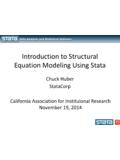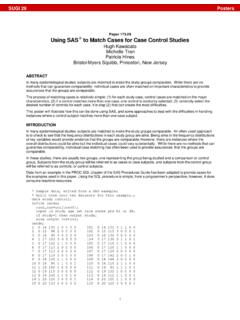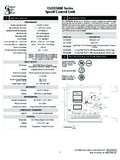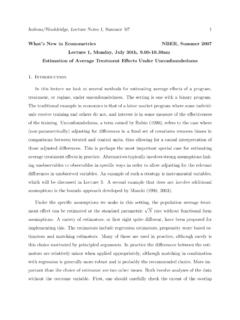Transcription of Case Control Matching - California
1 11/24/20141 case Control Matching with SPSS:A Tool to Reduce Selection Bias in Common IR StudiesAllan Taing, Research Technician, Carollo, Assistant Director, of Presentation Research question Matching SPSS case Control Matching Example from CSUSB Q and A11/24/20142 Research Question How can IR offices assess the impact of student services programs when students are not randomly selected/assigned to participate? Theory/Rationale for Matching Randomized experiments as the gold standard Shadish, Cook, & Campell (2002) case Control Matching as a quasi experimental design Matching on confounding variables to account for pre existing differences Reducing selection bias Improving internal validity11/24/20143 SPSS case Control Matching : Overview Point and Click with v.
2 22 Or via syntax with Python Essentials in older versions (v. 18 21) Fuzzy Matching on Matching variables Researcher defined tolerance levels/Fuzz Factor Random match from eligible suppliers Iterative Process One SPSS file: Demanders and Suppliers, coded 1 and 0, respectively Unique ID variable for each case Matching variables and outcome variablesSPSS case Control Matching : Step by Step1. Prep data; Identify Matching variables2. Run SPSS case Control Matching3. Create new dataset for matched demanders and suppliers4. Compare matched groups on Matching variables for non significance5.
3 Analyze outcome variables for any significant group differences11/24/20144 SPSS case Control Matching : DemonstrationExample: EOP Matching11/24/20145 Example: EOP Retention RatesTable 1. Retention ComparisonEOP vs. Non Matched StudentsCohort GroupCount2nd Year Retention3rd Year retention4th Year RetentionFall 2008 EOP25087%*72%66%All Non EOP171882%67%61%Fall 2009 EOP24389%79%*72%All Non EOP177484%72%66%Fall 2010 EOP24991%85%* All Non EOP152488%78% Fall 2011 EOP24391% All Non EOP188887% EOP98589%*78%*69%*TotalAll Non EOP690485%72%64%Table 2. Retention ComparisonEOP vs. Matched StudentsCohort GroupCount2nd Year Retention3rd Year retention4th Year RetentionFall 2008 EOP25087%72%66%Matched Non EOP 25081%66%61%Fall 2009 EOP24389%*79%72%Matched Non EOP 24382%72%66%Fall 2010 EOP24991%*85% Matched Non EOP 24987%78% Fall 2011 EOP24391% Matched Non EOP 24386% EOP98589%*78%*69%*TotalMatched Non EOP 98584%72%62%Example: EOP GPA ComparisonsTable 3.
4 First Term GPA ComparisonEOP vs. Non Matched StudentsCohortGroupFirst Term GPAFall Non Non Non Non Non 4. First Term GPA ComparisonEOP vs. Matched StudentsCohortGroupFirst Term GPAFall *Matched Non Non Non *Matched Non *Matched Non Impact EOP Director: For many years, our student population was being compared with other students that did not have comparable characteristics. We did not feel that the available data accurately provided a true comparison, nor the added value of our program and services provided for the population that we serve. With the introduction of the case Control Matching technique, our department is now able to measure and compare students with similar attributes.
5 This allows us to truly assess the significant impact our services and interventions have on the students that participate in our program. Conclusion case Control Matching is a useful tool to reduceselection bias when analyzing the effectiveness of student services programs Deciding on Matching variables and tolerance levels is crucial Check the matched groups for similarities before analyzing outcomes IR studies can have broad impact for campus stakeholders11/24/20147 Thank Yo u ! Questions? Contact us! 909 537 5052 SPSS case - Control Matching 2014 CAIR Conference San Diego Allan Taing and Tanner Carollo SPSS case - Control Matching using point-and-click is available in SPSS 22 or higher.
6 If you have an earlier version, you ll need to run the FUZZY Matching syntax by installing Python Essentials. STEP 1: PREP YOUR DATA Create a single SPSS file with treatment/participant cases (demanders), and Control /non-participant cases (suppliers). Each case needs to have a unique ID variable. In addition to the Matching and outcome variables, create a binary group indicator variable to distinguish demanders (1) and suppliers (0). STEP 2: RUN case - Control Matching Open the case - Control Matching dialog box from the Menu Bar [Data > case - Control Matching ] Use the arrow button to move the variables you would like to match on from the Variables box to the Variables to Match On box [ , GENDER, ETHNICITY, PELL_STAT, HS_GPA, SAT].
7 Set your tolerances/fuzz factor in the Match Tolerances box. You ll need to identify a tolerance value for each Matching variable in order listed in the Variables to Match On box above and separated by a single blank space. o String values must have a tolerance value of 0. o A tolerance value of 0 for continuous variables would result in exact matches on those variables. In this example, the tolerance level is set to .1 for GPA, and 50 for SAT. Move the demander/supplier indicator variable to the Group Indicator box [ , GROUP_IND]. Move the unique ID variable to the case ID box [ , STUDENT_ID].
8 Create a variable name in the Names for Match ID Variables box. o If a demander case is matched with a supplier case , the supplier case s case ID will populate this variable in the demander case [ , match_id]. Create a variable name in the Matchgroup Variable box. o This is used by SPSS when identifying matches; you will not be using this variable [ mgv]. 909-537-5052 Next, click on the Additional Output button Click on the checkbox to Create new dataset of matches, and type in a name for the new dataset. o SPSS will create a new dataset for the supplier cases that have an identified match to the demander cases (you can name it supplier_matched).
9 Click Continue in the Additional Output, then click OK in the case - Control Matching dialog box to run the program. case - Control Matching is an iterative process; you may have to run this a few times while adjusting your Match Tolerances, or fuzz factor, to obtain an acceptable sample size. Once you have obtained an acceptable number of matches, you can move to the next steps. There are no rules for an acceptable number of matches, but the match tolerance ranges should be justifiable on theoretical/practical grounds. STEP 3: BUILD MATCHED DATASET Create a dataset with only the matched demander cases and supplier cases.
10 In your original dataset, go to the Select Cases dialog box, and under If condition is satisfied select cases [IF match_id NE 0], and for output, Copy the selected cases to a new dataset (you can name it demander_matched). In the new dataset, merge in the supplier_matched dataset [Data > Merge Files > Add Cases]. This merged dataset will now have all of the matched demander cases and matched supplier cases. STEP 4: CHECK Matching VARIABLES Compare the matched demander cases and matched supplier cases on the Matching variables For categorical variables, run frequencies to ensure that the distributions are equal For continuous variables, run t-tests to ensure that there is non-significance.










